| Article ID | Journal | Published Year | Pages | File Type |
|---|---|---|---|---|
| 7245456 | Journal of Environmental Psychology | 2016 | 56 Pages |
Abstract
Research indicates that people are drawn to green spaces with attractive amenities. This study extends that finding by comparing walking patterns in two neighborhoods with different numbers of parks; parks did not differ in rated attractiveness nor did neighborhoods differ substantially in rated walkability. Adults, aged 32-86 years (n = 90), drew their 3 most recent walking routes on maps of their neighborhood. Analyses showed that participants' round trips were longer by 265.5 m (0.16 mile) in the neighborhood with a single, large, centrally located park (p < 0.02). However, participants in the neighborhood with multiple, small, more distributed parks, visited more streets, p < 0.001, more streets with green spaces, p < 0.038, and used more varied routes, p < 0.012. Results suggest there are potential benefits to both layouts. Large centralized parks may invite longer walks; smaller, well-distributed parks may invite more varied routes suggestive of appropriation and motivation processes. Both layouts might be combined in a single neighborhood to attract more walkers.
Related Topics
Social Sciences and Humanities
Psychology
Applied Psychology
Authors
Liliane Rioux, Carol M. Werner, Rene Mokounkolo, Barbara B. Brown,
